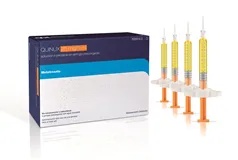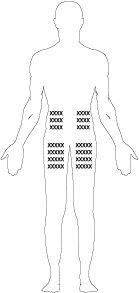

КВИНУКС 10 мг/0,4 мл РАСТВОР ДЛЯ ИНЪЕКЦИЙ В ПРЕДНАПОЛНЕННОМ ШПРИЦЕ


Инструкция по применению КВИНУКС 10 мг/0,4 мл РАСТВОР ДЛЯ ИНЪЕКЦИЙ В ПРЕДНАПОЛНЕННОМ ШПРИЦЕ
Введение
Прошу: информация для пациента
КВИНУКС 10 мг/0,4 мл раствор для инъекций в предварительно заполненном шприце
Метотрексат
Прочитайте внимательно весь листок-вкладыш перед началом использования этого лекарства, поскольку он содержит важную информацию для вас.4. Возможные побочные эффекты Как и все лекарства, это лекарство может вызывать побочные эффекты, хотя не все люди испытывают их. Частота и степень тяжести побочных эффектов будут зависеть от дозы и частоты введения. Важно, чтобы врач проводил периодические осмотры, поскольку могут возникать тяжелые побочные эффекты даже при самых низких дозах. Ваш врач будет проводить тесты для контроля аномалий, которые могут возникнуть в крови, таких как низкий уровень лейкоцитов (белых кровяных телец), тромбоцитов, лимфомы и изменений в почках и печени. Самые значимые побочные эффекты, связанные с введением Квинукса, возникают в системе кроветворения и желудочно-кишечном тракте. Сообщите своему врачу немедленно, если вы испытываете любой из следующих симптомов, поскольку они могут указывать на тяжелый побочный эффект с потенциальной угрозой для жизни, который может потребовать срочного специального лечения: Могут возникать следующие побочные эффекты: Очень часто(могут возникать у более 1 из 10 человек): Часто(могут возникать у до 1 из 10 человек): Не часто(могут возникать у до 1 из 100 человек): Редко(могут возникать у до 1 из 1000 человек): Очень редко(могут возникать у до 1 из 10 000 человек): Частота не известна(не может быть оценена на основе доступных данных): При введении метотрексата внутримышечно могут возникать местные побочные реакции (чувство жжения) или повреждения (формирование стерильных абсцессов, разрушение жировой ткани) в месте введения. Подкожное введение метотрексата обычно хорошо переносится местно. Были обнаружены только легкие местные кожные реакции, которые уменьшались во время лечения. Сообщение о побочных эффектах Если вы испытываете любой побочный эффект, проконсультируйтесь с вашим врачом, фармацевтом или медсестрой, даже если это возможные побочные эффекты, которые не указаны в этом описании. Вы также можете сообщить о них напрямую через Испанскую систему фармакологического надзора за лекарствами для человека. https://www.notificaram.es. Сообщая о побочных эффектах, вы можете способствовать предоставлению более полной информации о безопасности этого лекарства. Храните это лекарство в недоступном для детей месте. Не храните при температуре выше 25 °C. Храните предзагруженные шприцы в наружной упаковке, чтобы защитить их от света. Не охлаждайте и не замораживайте. Не используйте это лекарство после истечения срока годности, указанного на упаковке после CAD. Срок годности - последний день месяца, указанного. Лекарства не должны выбрасываться в канализацию или мусор. Поместите упаковку и лекарства, которые вам больше не нужны, в пункт SIGRE аптеки или любую другую систему сбора отходов лекарств. Если у вас есть сомнения, спросите у вашего фармацевта, как избавиться от упаковки и лекарств, которые вам больше не нужны. Таким образом, вы поможете защитить окружающую среду. Состав Квинукса 1 предзагруженный шприц с 0,4 мл раствора содержит 10 мг метотрексата. Внешний вид продукта и содержимое упаковки Предзагруженные шприцы Квинукса содержат прозрачный желтоватый раствор. <Исключительно для упаковок, содержащих шприцы с системой безопасности> Шприц оснащен системой безопасности, чтобы помочь предотвратить травмы от уколов после использования. Каждая упаковка содержит 1 или 4 предзагруженных шприца(ов) с 0,4 мл раствора, с присоединенными иглами для подкожных инъекций и ватными шариками, пропитанными спиртом. Каждая упаковка содержит 1 или 4 предзагруженных шприца(ов) с 0,4 мл раствора, с присоединенными иглами для подкожных инъекций с системой безопасности и ватными шариками, пропитанными спиртом. Возможно, не все размеры упаковок будут продаваться. Владелец разрешения на продажу и ответственный за производство Владелец разрешения на продажу Фармацевтическая компания Centrum, S.A. Улица Сагитарио, 14 03006, Аликанте ИспанияГруппа Asacpharma Телефон: 965288160; Факс: 965286434 Ответственный за производство Фармацевтическая компания Centrum, S.A. Улица Сагитарио, 14 03006, Аликанте Испания Дата последнего пересмотра этого описания: октябрь 2024 г. Подробная информация о этом лекарстве доступна на сайте Испанского агентства по лекарствам и медицинским изделиям (AEMPS) (http://www.aemps.gob.es) Инструкции по применению Внимательно прочитайте инструкции перед началом введения инъекции и всегда используйте рекомендуемую вашим врачом, медсестрой или фармацевтом технику введения. Если у вас есть какие-либо проблемы или вопросы, обратитесь к вашему врачу, медсестре или фармацевту. Подготовка Выберите чистую, ровную и хорошо освещенную рабочую поверхность. Соберите все необходимые элементы перед началом: Тщательно вымойте руки. Перед использованием проверьте шприц Квинукса на наличие видимых дефектов (или трещин). Место инъекции Лучшие места для инъекции: Введение раствора <Исключительно для упаковок, содержащих шприцы с системой безопасности> Защитный колпачок автоматически закроет иглу. Метотрексат не должен контактировать с кожей или слизистыми оболочками. В случае загрязнения необходимо немедленно промыть пораженную область большим количеством воды. Если вы или кто-то из вашего окружения поранился иглой, немедленно обратитесь к врачу и не используйте этот предзагруженный шприц. Утилизация и другие манипуляции Обращение и утилизация лекарства и предзагруженного шприца будут осуществляться в соответствии с местными правилами для цитотоксических агентов. Беременный медицинский персонал не должен обращаться с Квинуксом или вводить его.5. Хранение Квинукса
6. Содержимое упаковки и дополнительная информация






Сколько стоит КВИНУКС 10 мг/0,4 мл РАСТВОР ДЛЯ ИНЪЕКЦИЙ В ПРЕДНАПОЛНЕННОМ ШПРИЦЕ в Испании в 2025 году?
Средняя цена на КВИНУКС 10 мг/0,4 мл РАСТВОР ДЛЯ ИНЪЕКЦИЙ В ПРЕДНАПОЛНЕННОМ ШПРИЦЕ в ноябрь, 2025 года составляет около 13.49 евро. Финальная стоимость может зависеть от региона, конкретной аптеки и рецептурного статуса. Для точной информации лучше проверить онлайн или в ближайшей аптеке.
- Страна регистрации
- Средняя цена в аптеках13.49 EUR
- Активное вещество
- Требуется рецептДа
- Производитель
- Информация носит справочный характер и не является медицинской рекомендацией. Перед приемом любых препаратов проконсультируйтесь с врачом. Oladoctor не несет ответственности за медицинские решения, принятые на основе этого контента.
- Аналоги КВИНУКС 10 мг/0,4 мл РАСТВОР ДЛЯ ИНЪЕКЦИЙ В ПРЕДНАПОЛНЕННОМ ШПРИЦЕФорма выпуска: ИНЪЕКЦИОННЫЙ РАСТВОР, 10 мг/ 1 млАктивное вещество: МетотрексатПроизводитель: Ebewe Pharma Ges.M.B.H. Nfg.KgТребуется рецептФорма выпуска: ИНЪЕКЦИОННЫЙ РАСТВОР, 15 мгАктивное вещество: МетотрексатПроизводитель: Ebewe Pharma Ges.M.B.H. Nfg.KgТребуется рецептФорма выпуска: ИНЪЕКЦИОННЫЙ РАСТВОР, 20 мгАктивное вещество: МетотрексатПроизводитель: Ebewe Pharma Ges.M.B.H. Nfg.KgТребуется рецепт
Аналоги КВИНУКС 10 мг/0,4 мл РАСТВОР ДЛЯ ИНЪЕКЦИЙ В ПРЕДНАПОЛНЕННОМ ШПРИЦЕ в других странах
Лучшие аналоги с тем же действующим веществом и терапевтическим эффектом.
Аналог КВИНУКС 10 мг/0,4 мл РАСТВОР ДЛЯ ИНЪЕКЦИЙ В ПРЕДНАПОЛНЕННОМ ШПРИЦЕ в Польша
Аналог КВИНУКС 10 мг/0,4 мл РАСТВОР ДЛЯ ИНЪЕКЦИЙ В ПРЕДНАПОЛНЕННОМ ШПРИЦЕ в Украина
Врачи онлайн по КВИНУКС 10 мг/0,4 мл РАСТВОР ДЛЯ ИНЪЕКЦИЙ В ПРЕДНАПОЛНЕННОМ ШПРИЦЕ
Консультация по дозировке, побочным эффектам, взаимодействиям, противопоказаниям и продлению рецепта на КВИНУКС 10 мг/0,4 мл РАСТВОР ДЛЯ ИНЪЕКЦИЙ В ПРЕДНАПОЛНЕННОМ ШПРИЦЕ – по решению врача и с учетом местных правил.





